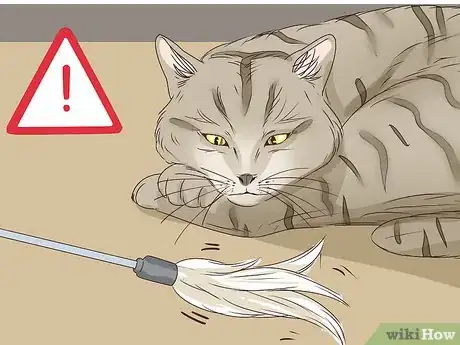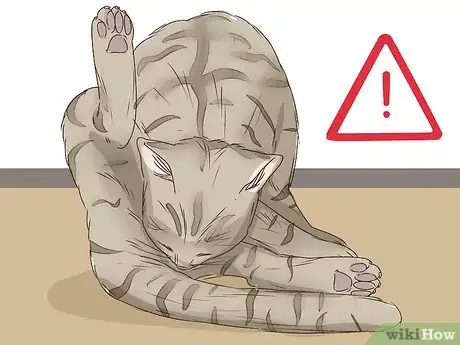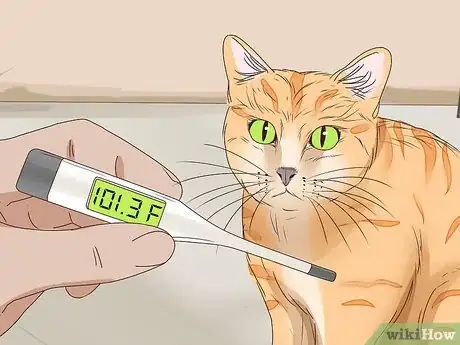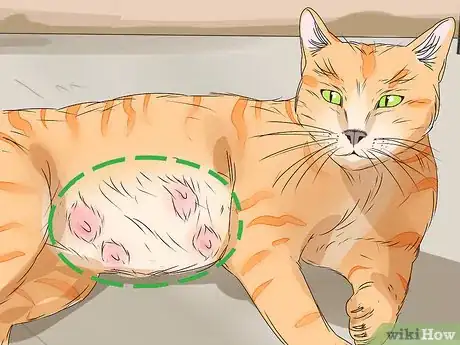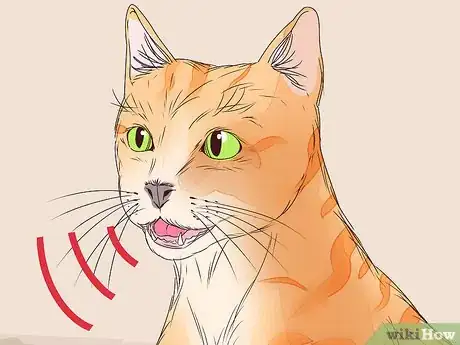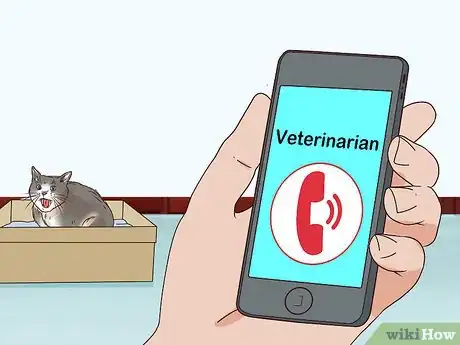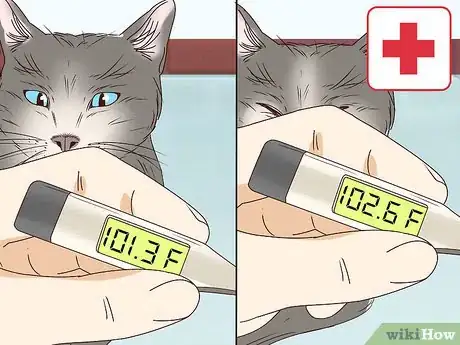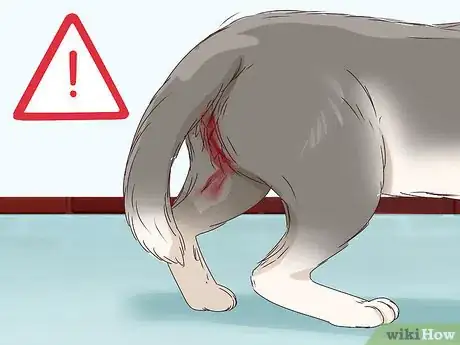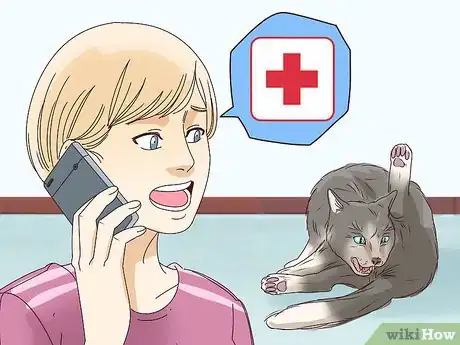This article was co-authored by Pippa Elliott, MRCVS. Dr. Elliott, BVMS, MRCVS is a veterinarian with over 30 years of experience in veterinary surgery and companion animal practice. She graduated from the University of Glasgow in 1987 with a degree in veterinary medicine and surgery. She has worked at the same animal clinic in her hometown for over 20 years.
wikiHow marks an article as reader-approved once it receives enough positive feedback. This article received 16 testimonials and 91% of readers who voted found it helpful, earning it our reader-approved status.
This article has been viewed 151,645 times.
A domestic cat has a gestation period of approximately 63 days. If you don’t know the exact date of conception, however, you may not have a clear idea of when your cat is ready to go into labor (known as queening).[1] If you keep a watchful eye for some tell-tale behavioral and physical signs that labor is approaching, however, you will be able to care for her and know whether or not queening is proceeding normally.
Steps
Looking for Behavioral Signs
-
1Observe the cat looking for a nest. In the days leading up to queening, a pregnant cat will start looking for a nest, or suitable place to give birth to and care for her kittens. Many cats that are about to give birth will seek privacy, like a closet or other hiding spot. If you notice yours investigating areas like this, you can lay a blanket or towels down to make it more comfortable.[2] [3]
- You can also offer your cat a nest, such as a cardboard box. Be aware that many cats will want to choose their own nest, and may even change locations.
-
2Look for changes in behavior. As her due date approaches, your cat may begin to appear restless, and pace around frequently. You may also notice her changing habits. For instance, if you have a cat that is normally aloof, she may become more affectionate near her due date, or vice versa.[4]Advertisement
-
3Notice if your cat skips a meal. Pregnant cats will typically eat more than usual. Once queening nears, however, they may have a reduced appetite or even stop eating all together.[5]
-
4Watch for your cat to wash her genital area. The onset of queening entails physiological changes, which your cat will start to sense. In particular, you may see her washing or licking her genital area. This may or may not be accompanied by a mucous discharge, which signals that labor is very near.[6]
Examining Your Cat
-
1Take the cat’s temperature. Checking a cat’s temperature beginning around the 60th day after breeding can give a relatively reliable indication that queening is near. Even if you aren’t sure of the breeding date, regularly checking your cat’s temperature once it is quite pregnant can be a useful indicator.[7] [8]
- Rectal temperature of a pregnant cat varies between 100.5 and 102 degrees Fahrenheit
- Within two hours before labor, rectal temperature should drop, as much as 2 degrees.
-
2Observe your cat’s physical condition. When a pregnant cat’s queening date approaches, its nipples and mammary glands will enlarge. Your cat may also begin to lick its nipples. Other physical signs include a descended (dropped) abdomen, and an enlarged and softened vulva. All of these signs should be fairly obvious upon visual inspection.[9]
-
3Pay attention to your cat’s breathing patterns. If you suspect that queening is imminent, and your cat allows you to get near it, listen closely to its breathing. Its breathing rate may become more rapid, and it may even begin to start panting. Your cat may also purr rhythmically and continuously.[10]
-
4Feel for straining and tension in the abdomen. When birthing is very close, your cat will begin to have contractions. You can tell if these are happening by gently feeling its abdomen. Tension and straining in the abdominal area likely signify that contractions are taking place. You may also be able to see your cat’s abdomen contracting and releasing. Your cat may lay on its side during this time, making an inspection easier.[11] [12]
Watching for Warning Signs
-
1Call a vet if labor is prolonged. Most cats are able to queen all by themselves. Keep a close eye on yours if it looks like labor is about to begin, however. If signs (such as contractions) indicate that you cat is in forceful labor, but nothing happens after an hour of effort, contact a vet immediately. He or she can determine how to help your cat.[13] [14]
-
2Observe your cat closely if its temperature increases. Checking your cat’s temperature will not only indicate when queening is near, but also if there are potential problems. Normally, a cat’s temperature will drop near queening time. If your cat’s temperature rises, watch it closely and check it again as soon as possible. If the temperature is still higher than normal, contact a vet.[15]
-
3Look for suspicious discharges. Some bleeding may accompany the queening process. Pregnant cats will also have discharges of mucous and amniotic fluid when birthing is near. However, if you notice excessive bleeding or a foul smelling discharge, contact a vet, as these signs may indicate a problem.[16]
-
4Pay attention if your cat seems in pain. Queening will entail some discomfort and behavioral changes, so it may be difficult to tell if your cat is all right. Most cats will queen just fine all by themselves. However, if your cat bites its genital area or cries and licks at it, consider calling a vet to rule out any potential problems.[17]
-
5
Expert Q&A
-
QuestionHow long does it take for a cat to be in labor?
 Pippa Elliott, MRCVSDr. Elliott, BVMS, MRCVS is a veterinarian with over 30 years of experience in veterinary surgery and companion animal practice. She graduated from the University of Glasgow in 1987 with a degree in veterinary medicine and surgery. She has worked at the same animal clinic in her hometown for over 20 years.
Pippa Elliott, MRCVSDr. Elliott, BVMS, MRCVS is a veterinarian with over 30 years of experience in veterinary surgery and companion animal practice. She graduated from the University of Glasgow in 1987 with a degree in veterinary medicine and surgery. She has worked at the same animal clinic in her hometown for over 20 years.
Veterinarian Much like human labor, there are different stages. All in, labor can take a day, when you include first stage labor where the womb tones up and the cat experiences mild contractions. During this phase, the cat may be restless and unsettled. Active labor with straining usually lasts just a few hours. If the cat is pushing hard for an hour, with no kitten emerging, then contact the vet as an emergency.
Much like human labor, there are different stages. All in, labor can take a day, when you include first stage labor where the womb tones up and the cat experiences mild contractions. During this phase, the cat may be restless and unsettled. Active labor with straining usually lasts just a few hours. If the cat is pushing hard for an hour, with no kitten emerging, then contact the vet as an emergency. -
QuestionHow can you tell if your cat's pregnant or not?
 Pippa Elliott, MRCVSDr. Elliott, BVMS, MRCVS is a veterinarian with over 30 years of experience in veterinary surgery and companion animal practice. She graduated from the University of Glasgow in 1987 with a degree in veterinary medicine and surgery. She has worked at the same animal clinic in her hometown for over 20 years.
Pippa Elliott, MRCVSDr. Elliott, BVMS, MRCVS is a veterinarian with over 30 years of experience in veterinary surgery and companion animal practice. She graduated from the University of Glasgow in 1987 with a degree in veterinary medicine and surgery. She has worked at the same animal clinic in her hometown for over 20 years.
Veterinarian An early clue is if the female cat's nipples 'pink up'. In a normal non-pregnant cat, her nipples are small and not particularly noticeable. Pinked-up nipples are fuller, more obvious, and more rosy than before. This is not a foolproof sign and a vet will need to feel her belly to get more clues.
An early clue is if the female cat's nipples 'pink up'. In a normal non-pregnant cat, her nipples are small and not particularly noticeable. Pinked-up nipples are fuller, more obvious, and more rosy than before. This is not a foolproof sign and a vet will need to feel her belly to get more clues. -
QuestionHow long does it take for a cat to give birth?
 Pippa Elliott, MRCVSDr. Elliott, BVMS, MRCVS is a veterinarian with over 30 years of experience in veterinary surgery and companion animal practice. She graduated from the University of Glasgow in 1987 with a degree in veterinary medicine and surgery. She has worked at the same animal clinic in her hometown for over 20 years.
Pippa Elliott, MRCVSDr. Elliott, BVMS, MRCVS is a veterinarian with over 30 years of experience in veterinary surgery and companion animal practice. She graduated from the University of Glasgow in 1987 with a degree in veterinary medicine and surgery. She has worked at the same animal clinic in her hometown for over 20 years.
Veterinarian Once the cat is in active labor and pushing, it's just a few hours. However, this is with the cat resting in between deliveries. Once she starts to push again, the next kitten should pop out within 20-30 minutes. Active straining for an hour or more, without the appearance of a kitten, is a sign she's in trouble and a vet needs to be contacted with urgency.
Once the cat is in active labor and pushing, it's just a few hours. However, this is with the cat resting in between deliveries. Once she starts to push again, the next kitten should pop out within 20-30 minutes. Active straining for an hour or more, without the appearance of a kitten, is a sign she's in trouble and a vet needs to be contacted with urgency.
References
- ↑ http://www.banfield.com/getmedia/91094b94-7950-4008-b924-a022b9bf1a36/Queening-and-Whelping.pdf
- ↑ http://cfa.org/Breeders/Articles/BirthingandRaisingKittens.aspx
- ↑ http://www.banfield.com/getmedia/91094b94-7950-4008-b924-a022b9bf1a36/Queening-and-Whelping.pdf
- ↑ http://www.banfield.com/getmedia/91094b94-7950-4008-b924-a022b9bf1a36/Queening-and-Whelping.pdf
- ↑ http://cfa.org/Breeders/Articles/BirthingandRaisingKittens.aspx
- ↑ http://cfa.org/Breeders/Articles/BirthingandRaisingKittens.aspx
- ↑ http://cfa.org/Breeders/Articles/BirthingandRaisingKittens.aspx
- ↑ http://www.sunshinerescuegroup.org/PregnancyInCats.pdf
- ↑ http://www.peteducation.com/article.cfm?c=1+2139&aid=919
- ↑ http://www.banfield.com/getmedia/91094b94-7950-4008-b924-a022b9bf1a36/Queening-and-Whelping.pdf
- ↑ http://cfa.org/Breeders/Articles/BirthingandRaisingKittens.aspx
- ↑ http://www.banfield.com/getmedia/91094b94-7950-4008-b924-a022b9bf1a36/Queening-and-Whelping.pdf
- ↑ http://cfa.org/Breeders/Articles/BirthingandRaisingKittens.aspx
- ↑ http://www.banfield.com/getmedia/91094b94-7950-4008-b924-a022b9bf1a36/Queening-and-Whelping.pdf
- ↑ http://cfa.org/Breeders/Articles/BirthingandRaisingKittens.aspx
- ↑ http://www.sunshinerescuegroup.org/PregnancyInCats.pdf
- ↑ http://www.banfield.com/getmedia/91094b94-7950-4008-b924-a022b9bf1a36/Queening-and-Whelping.pdf
- ↑ http://www.banfield.com/getmedia/91094b94-7950-4008-b924-a022b9bf1a36/Queening-and-Whelping.pdf
- ↑ http://www.sunshinerescuegroup.org/PregnancyInCats.pdf
About This Article
To tell if a cat is in labor, keep an eye out for physical and behavioral changes. The cat may seem restless and start pacing around the room. You might also notice it eating less and less. Cats often eat little to nothing in the few days leading up to labor. As well as behavioral changes, you may also notice that a cat’s body starts to change. For example, its nipples and mammary glands should become enlarged as it’s preparing to give birth. If you notice your cat licking its genitals and nipples, it’s getting ready to go into labor. The cat’s temperature will also drop a degree or 2 just before it gives birth. However, if your cat’s temperature rises, it starts to bleed excessively, or you notice a foul smelling discharge, call your vet as soon as possible, since these could be signs of labor complications. For more tips from our Veterinary co-author, including how to feel for contractions in your cat’s abdominal area, read on!

